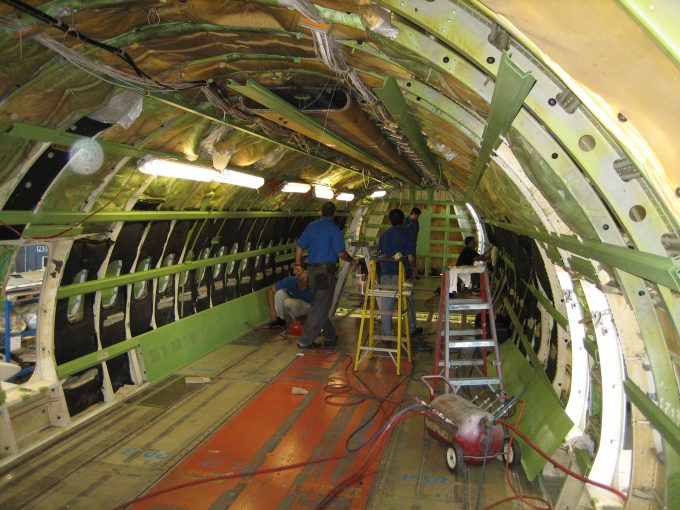Freighter aircraft: 'we are on the cusp of major change in large widebodies'
Even with 21% of the fleet parked, freighters will continue hauling a large share of ...
TFII: SOLID AS USUALMAERSK: WEAKENINGF: FALLING OFF A CLIFFAAPL: 'BOTTLENECK IN MAINLAND CHINA'AAPL: CHINA TRENDSDHL: GROWTH CAPEXR: ANOTHER SOLID DELIVERYMFT: HERE COMES THE FALLDSV: LOOK AT SCHENKER PERFORMANCEUPS: A WAVE OF DOWNGRADES DSV: BARGAIN BINKNX: EARNINGS OUTODFL: RISING AND FALLING AND THEN RISING
TFII: SOLID AS USUALMAERSK: WEAKENINGF: FALLING OFF A CLIFFAAPL: 'BOTTLENECK IN MAINLAND CHINA'AAPL: CHINA TRENDSDHL: GROWTH CAPEXR: ANOTHER SOLID DELIVERYMFT: HERE COMES THE FALLDSV: LOOK AT SCHENKER PERFORMANCEUPS: A WAVE OF DOWNGRADES DSV: BARGAIN BINKNX: EARNINGS OUTODFL: RISING AND FALLING AND THEN RISING

The ripples from the grounding of Boeing’s 737 MAX aircraft are now hitting 737 freighter conversions.
Given the uncertainty over the return of the aircraft type into service, airlines that were in the process of converting their narrowbody fleets from 737NGs to the MAX type are holding on to the older aircraft.
And as 737NG feedstock is freezing up, conversion activity is forced into slow gear.
Israel Aerospace Industries (IAI) was one of the first conversion providers out of the gates with a 737NG programme, starting with the 737-700. Down the road, it intends to add -800 conversions.
Refael Matalon, executive vice-president marketing, confirmed: “Now the market is a bit slow in NG conversions because of the MAX problems. Airlines have extended their NG leases.”
Aeronautical Engineers Inc (AEI) also led NG conversion action with its programme for the 737-800, the type widely seen as the dominant narrowbody freighter in the years ahead. Not only is it larger than the -700, but there is also abundant feedstock, compared with only about 1,000 737-700s.
At the moment, however, the -800 is proving as elusive as the -700 when it comes to conversion candidates.
“The -800 market has dried up and is getting worse by the day,” reported Bob Convey, AEI’s senior vice-president, sales & marketing.
IAI’s Mr Matalon is confident that work on the 737-700 will ramp up again soon: “There will be more in a few months,” he predicted.
But Mr Convey is less confident. He reckons the fall-out from the MAX crisis will extend beyond the plane’s return to service.
“I do not see NGs freeing up for several years, given the mistrust in Boeing,” he added.
Interest in converted 737NG freighters remains strong. On 11 February, leasing firm BBAM signed a contract with Boeing for the conversion of three 737-800s from the lessor’s fleet.
Boeing projects demand for 1,220 narrowbody jet freighter conversions over the next 20 years, while rival Airbus forecasts a need for about 1,000.
The US plane maker announced earlier that a new 737-800 conversion line at Guangzhou Aircraft Maintenance Engineering Co, a joint venture of China Southern Airlines and Hutchison Whampoa, should commence activities this summer.
Some companies are not waiting for NG conversions to pick up speed. According to Mr Convey, interest in 737-400 conversions has enjoyed a revival in the wake of the MAX problems.
“We are seeing a dramatic reversal back to the -400 and should have more than ten in work by year’s end,” he reported. “I’m not sure how next year will look as feedstock is drying up, but there are still 20 or 30 candidates out there.”
He does not think that the situation will spark a conversion programme for the Airbus A320. Airbus declared its intention to launch this years ago but has yet to pull the trigger.
Meanwhile, the first converted A321 freighter version, which competes at the lower end of the mid-sized freighter segment with the B757, took to the skies for its maiden flight on 5 February, with the first delivery due this summer.
“I am not a believer in the A320. I think it has missed its market,” Mr Convey said. “The only hope in my eyes for the A320 is as an add-on to A321 operators who want to go smaller.”
Still, the prospect of buoyant demand for narrowbody freighters fuelled by the e-commerce boom might convince Airbus that now would be a good time to launch an A320 conversion programme.
Comment on this article